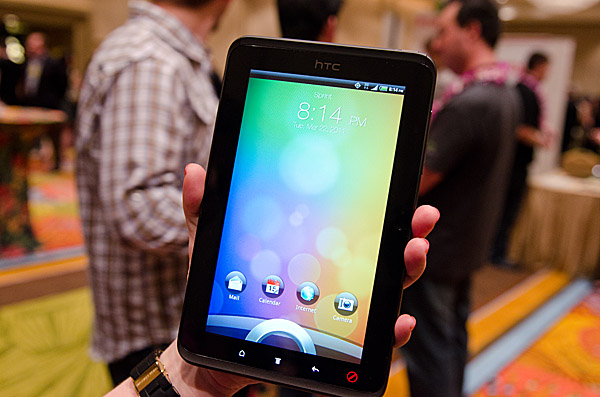CTIA Hands On Extravaganza: LG Optimus 3D and G2x, HTC Flyer, HD7S, EVO 3D, and Galaxy Tab 10.1, 8.9
by Anand Lal Shimpi on March 23, 2011 2:31 AM ESTHTC Flyer
HTC announced the Flyer at MWC last month but I didn't get to spend any real time with a functional device in Barcelona, so when given the opportunity to at CTIA I gladly took HTC up on the offer.
The Flyer isn't your typical 2011 Android tablet - for starters it isn't sporting Honeycomb. Remember that NVIDIA was Google's chosen SoC partner on Honeycomb, and as a result all other SoC vendors got a later start to porting Honeycomb to their platforms. Qualcomm falls into the latter group and as a result, even tablets that use Qualcomm hardware are shown off using Android 2.2 for now as porting/testing of Honeycomb commences.
HTC's first tablet, the Flyer, is no exception. Running Android 2.2 and a single-core 1.5GHz Qualcomm MSM8655 SoC, the Flyer already sounds very different from other tablets. The Flyer has a 7-inch 1024 x 600 screen and to further differentiate itself it also comes with a capacitive pen that you can use to draw on the screen. Touch the pen to the screen and the Flyer takes a screenshot of what you're currently looking at, whether it's the home screen, email window or web browser and lets you annotate/draw all over it. Once you're done you can either discard the image and go back to doing whatever you were doing or share the image as a jpeg just like you would any other picture. It's a pretty neat idea with tons of potential.
Opting for a high speed single-core CPU is also pretty contrary to what we've seen from most Android tablets thus far. While I personally believe that the dual-core approach makes more sense for the overall user experience (having the second core really makes up for any funky scheduler inefficiencies), the comparison between a 1.5GHz Scorpion core and a pair of 1GHz Cortex A9s won't be as cut and dry as that. The majority of smartphone apps are still bound by the performance of a single thread - where a 1.5GHz single-core Snapdragon could be even faster than a 1GHz Cortex A9.
Sprint announced that it will have the Flyer on sale as the EVO View 4G, featuring WiMAX.













22 Comments
View All Comments
cactusdog - Wednesday, March 23, 2011 - link
Anand, can you do a story on the OWC accusation that OCZ is using poor quality nand in their SSD's?Its important for customers to know who is telling the truth.
Thanks
softdrinkviking - Wednesday, March 23, 2011 - link
i am curious about that too.i also remember reading something about OCZ purposefully making their controllers more tolerant so that they could use cheaper nand without any problems.
strikeback03 - Wednesday, March 23, 2011 - link
That was one of the advantages Sandforce pushed for their controller, that it could make use of cheaper NAND because of its lower write-amplification and error checkingAnand Lal Shimpi - Wednesday, March 23, 2011 - link
It's an interesting story, I've been digging for the past few days on it. As far as I can tell the SpecTek NAND is rated for 3K cycles, just like normal Micron NAND (Intel NAND is rated at 5K).I don't believe there's any issue with SpecTek branded NAND (at least not what's in OWC's picture) but I'm trying to get my hands on some to test for myself to make sure.
Take care,
Anand
Shadowmaster625 - Wednesday, March 23, 2011 - link
OWC is lying, plain and simple. They are knowingly making false accusations. They should be sued by OCZ. OCZ has explained the situation very well. Spektek takes a failed wafer and sorts out the failures and sells the good pieces to OCZ. There is nothing substandard in the parts coming from Spektek, if they have the proper numbering ("AL" in this case.)What OWC is claiming is basically the same as saying that the three working cores of an Athlon X3 are somehow defective because there is a disabled core on the die. It is complete nonsense.
cactusdog - Thursday, March 24, 2011 - link
Well, it seems odd that the article is still up on OWC and OCZ forum mods are locking down threads and refusing to make any further comment.Anand, that would be good. Maybe you could contact spectek and/or Micron too to get their response.
Conficio - Wednesday, March 23, 2011 - link
Why do I need to have this 3D nonsense if I'd like a large phone with a good two core processor and a decent GPU? Really HTC, et. al. why do I need an odd 3D display and the bloat of driver software that means and the dual cameras of low quality.Where is a phone that invests the money into things that matter, like a good camera (8 Mega pixels, flash, recessed or protected as to not become a scratch magnet [ or some screw on cap tha can be replaced for a few dollars]), and a quality 2D screen [qHD sounds good to me], dual core processor, quad or penta band?
I'm in the market this year for a phone (and I replace a Treo 600, if you know what I mean).
jharper12 - Wednesday, March 23, 2011 - link
Anand,BlueScreen from the Android Forums, someone who allegedly works in software development for HTC and who leaked info on the original Evo, posted a couple of items of interest. First, he claimed the ROM in the Evo 3D was actually "RAM Silicon" and could function as RAM "Depending on the needs of the 2nd processor."
He also mentioned the HTC Shooter benchmarks that popped up earlier in the week. "I know there was some flak on the recent GLBenchmarks and we caught hell for it around here as well. I just wanted to let you know that fit and finish on that has been polished out. Memory allocation was only single set data stream and we have now been able to utilize duel data stream with a bump in memory clock speeds. I guess you could use the analogy of SDRAM compared to DDRAM... I can say that we were able to almost double our GLbench scores with just the memory fix though."
Do either of those things sound remotely possible to you? How do you think the MSM8660 is going to fair against OMAP offerings? How substantial is the difference between the A9 and A8? I've read it's approximately a 25% performance difference clock for clock, which if that's the case, would only give the 1Ghz A9 offerings a 8.5% performance advantage. Lots of random questions, but I suppose I'm most interested in whether or not that RAM ROM business even sounds feasible to you.
Thanks for the amazing website and reporting. This is always the first place I go when I want unbiased, benchmarking, tell it like it is reporting. I've learned a lot here.
Leaked HTC Shooter benchmarks - allegedly the Evo 3D using the MSM8660.
http://www.phonearena.com/news/Scores-for-the-unre...
jharper12 - Wednesday, March 23, 2011 - link
From reading more today, looks like this "inside man" was just trolling and spitting out random information. Sad... I wonder if that means those benchmarks are fairly indicative of how this phone will perform in relation to the other current gen platforms. Rough.PWRuser - Thursday, March 24, 2011 - link
Optimus 3D appears to be under the radar, all eyes are on the EVO but Optimus 3D is all around a very good phone. Dominates the Incredible as well.On the other hand, Tegra 3 and OMAP 5 already in the works, makes more sense to wait out unitl 28nm next gen SoC's start shipping.